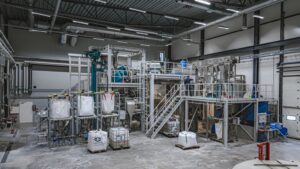Soils are teeming with bacteria whose effects we are just beginning to understand. One of the most abundant and active groups of bacteria in soils is called Bradyrhizobium. For the first time from European soils, scientists have sequenced the genome of Bradyrhizobium, giving a glimpse into their activity and revealing differences with strains from other parts of the world.
The scientists sequenced two strains of Bradyrhizobium collected from soils with different conditions, and found that one of the strains could contribute to greenhouse gas emissions. Working at the University of Reading and Rothamsted Research, which receives strategic funding from the BBSRC, the team of scientists last month published their findings in the journal Scientific Reports.
Bacteria, including Bradyrhizobium, can remove the nitrogen that plants need from the soil by converting it to gases released into the atmosphere. One step of this conversion produces nitrous oxide—a gas with around 300 times the global warming effect of carbon dioxide. In the final step, the bacteria convert nitrous oxide into harmless nitrogen gas. The scientists found that one of the two strains of Bradyrhizobium lacked the gene for the final step of the process, indicating that it can only create nitrous oxide that contributes to climate change. Because of the removal of soil nitrogen by bacteria, the supply to crop plants is reduced making fertiliser use less efficient.
The scientists collected the two strains of Bradyrhizobium from different soils of a long-term experiment at Rothamsted Research, where plots have been maintained as grassland or ploughed bare for 60 years. The two strains showed high diversity in their sequences, which the researchers think results from their adaptation to the grassland and bare soil conditions. Like much about microbial diversity, whether or not the sequenced strains are typical of those in UK soils is still unknown.
Lead author of the study, Frances Jones, said: “Bradyrhizobium is usually known for its close relationship with plants and so the fact that it is present in bare soil is exciting. Also, containing the genes for denitrification indicates that this group have the potential to be a major denitrifier which has implications for agriculture and global climate change. Looking into the genomes has given us insight into the ways the strains are adapted to their environments and will help direct future research into this key group of soil bacteria.”
Prof. Penny Hirsch, who leads the soil microbial ecology group at Rothamsted Research, commented: “Discovering that one of the most abundant groups of bacteria in soil is potentially responsible for major nitrogen losses, and showing how different treatments affect this group in the long-term, is an important step towards managing the soil to minimize fertilizer use whilst maintaining crop yields.”













